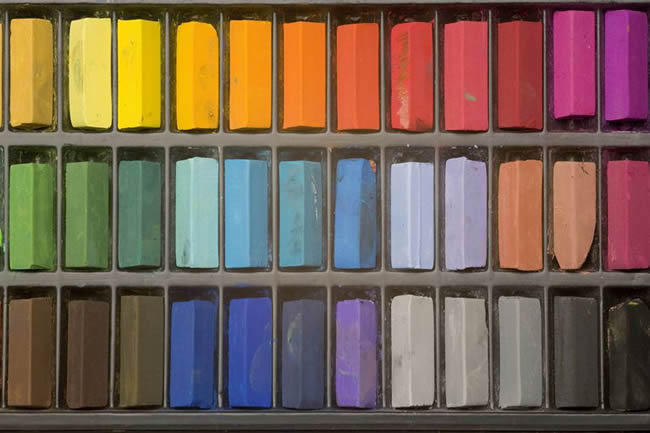
ChrisAt/Getty Images
Each of these pastel techniques can be used on their own or combined, to produce a pastel painting. There is no right or wrong way. As with so many things in painting, it comes down to what you enjoy doing with your pastels.
Remember to try each pastel technique with different pastels — hard, semi-soft, and soft — as each gives a slightly different result, as will the various pastel brands.
The simplest way to use a pastel is to draw with the end, holding it as you would a pencil or pen. The resultant line has great expression, conveying a sense of the gesture you made.
Alter the thickness of the line by varying the pressure you’re applying to the pastel. The harder you press, the more pastel you’ll be putting down on the sheet. For thinner lines, press more gently or use the edge.
Tip: Use your whole arm, not just your wrist, as this encourages broader, looser drawing.
If you want to work quickly, creating large blocks of color, use the side of a pastel stick. For optimal results break (yes, I said break) a stick in half and use that — remember, even the smallest fragment of pastel is still usable.
Altering the pressure will create different degrees of texture on the pastel paper. When the side of the pastel has worn down, giving two sharp edges, it can also be used to create fine lines.
Tip: This is best done with semi-soft or soft pastels.
If you've done any drawing then this technique will be familiar — in fact it is best suited to pastel pencils or hard pastel sticks. Hatching is simply a set of parallel lines, preferably fine lines (hence the pencil) drawn closely together. Cross-hatching is just the next step, drawing a second set of lines at an angle (most often at right angles to the first set).
This method is especially useful in pastel painting for the initial blocking in of a painting — it allows you to experiment with color and tone in a loose, flexible way without fully committing to a final composition.
Tip: You can use this method to create a sense of form and shape by varying the direction of the cross-hatching.
Unlike other mediums, pastels are not mixed before putting them on the paper. There are two ways to create color and tonal variations — optical blending, which is achieved by having colors in close proximity (see hatching), and blending, where the pastel is mixed on the paper.
You have a wide choice of tools to use for blending, although the traditional one is the finger (you must decide whether you want to wear a surgical glove to protect your hands or not). Also available are: the side of the hand — useful for large areas of blending, but not good for precise results; paper tools such as the tortillon, torchon, and paper stump; putty (or kneaded) rubbers, cloths, and cotton wool (balls or buds).
Tip 1: If using your finger (or hand) remember to clean it regularly to avoid contamination of the painting with colors previously blended. I keep a box of wet-wipes handy at all times, even when painting plein air.
Tip 2: Paper stumps and tortillons can be cleaned up for further use by unwinding a layer at the end or by removing the end surface with a pencil sharpener.
One of the great advantages of pastels over other mediums is the vibrancy you can achieve with color. Possibly the best method for getting this is by scumbling — after a layer of pastel has been applied, and fixed, lightly drag a soft pastel on its side across the top. This creates a broken covering of the new color over the top.
The result is visually stimulating and very textural, and careful choice of colors will produce amazing results.
Tip: This method works best with the softest soft pastels.
Feathering is a fine-tuned form of hatching using short strokes. The result is rather like scumbling — it can give a vibrancy to a painting. Feathering will also work for optical mixing of color (like with pointillist paintings) where the eye mixes the colors together rather than blending them on the paper.
Tip: This method is especially good for giving the appearance of iridescence of fabric, feathers, and scales, or for creating atmospheric effects with light.
Rather than scumbling a pastel over the top of an existing block of color, try dusting. Hold a pastel over the block of color (it is easier if this has been fixed, but not essential) and scrape the stick's surface to create dust. Once you are happy with the arrangement of dust on the paper, use a flat palette knife to press the dust into the surface.
